8-4-2. SEPARATION METHODS
- Views Views: 1,264
- Last updated Last updated:
-
8-4-2. SEPARATION METHODS
Lateral separation exists for:
- Nonintersecting flight paths:
- When the required distance is maintained between the flight paths; or (See FIG 8-4-1.)
FIG 8-4-1 Separation Methods 
- When reduced route protected airspace is applicable, and the protected airspace of the flight paths do not overlap; or (See FIG 8-4-2.)
FIG 8-4-2 Separation Methods 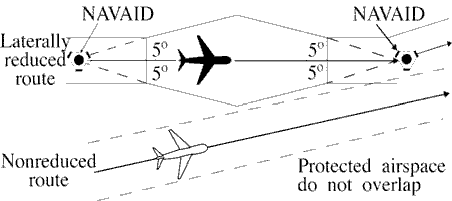
- When aircraft are crossing an oceanic boundary and are entering an airspace with a larger lateral minimum than the airspace being exited; and
- (a) The smaller separation exists at the boundary; and
- (b) Flight paths diverge by 15° or more until the larger minimum is established. (See FIG 8-4-3.)
FIG 8-4-3 Separation Methods 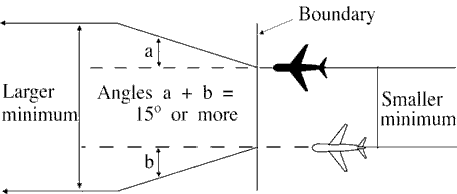
- When the required distance is maintained between the flight paths; or (See FIG 8-4-1.)
- Intersecting flight paths with constant and same width protected airspace when either aircraft is at or beyond a distance equal to the applicable lateral separation minimum measured perpendicular to the flight path of the other aircraft. (See FIG 8-4-4.)
FIG 8-4-4 Separation Methods 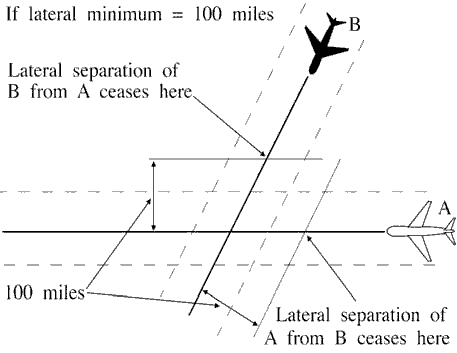
- Intersecting flight paths with constant but different width protected airspace when either aircraft is at or beyond a distance equal to the sum of the protected airspace of both flight paths measured perpendicular to the flight path of the other aircraft. (See FIG 8-4-5.)
FIG 8-4-5 Separation Methods 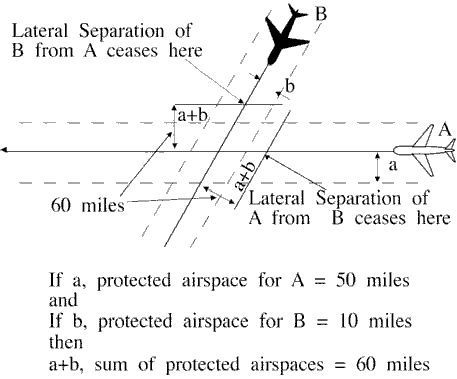
- Intersecting flight paths with variable width protected airspace when either aircraft is at or beyond a distance equal to the sum of the protected airspace of both flight paths measured perpendicular to the flight path of the other aircraft. Measure protected airspace for each aircraft perpendicular to its flight path at the first point or the last point, as applicable, of protected airspace overlap.
NOTE: In FIG 8-4-5, the protected airspace for westbound flight A is distance “a” (50 miles), and for southwest bound flight B, distance “b” (10 miles). Therefore, the sum of distances “a” and “b”; i.e., the protected airspace of Aircrafts A and B, establishes the lateral separation minimum (60 miles) applicable for either flight relevant to the other.
FIG 8-4-6 Separation Methods 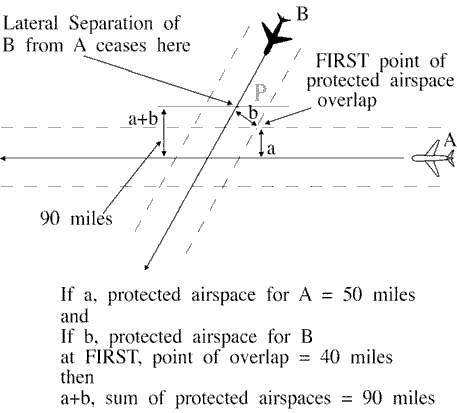
NOTE: (See FIG 8-4-6.) At the first point of protected airspace overlap, the protected airspace for westbound flight A is distance “a” (50 miles), and for southbound flight B, distance “b” (40 miles). The sum of distances “a” and “b” (90 miles) establishes the lateral separation minimum applicable in this example for either flight as it approaches the intersection. For example, Aircraft B should be vertically separated from Aircraft A by the time it reaches point “p.”
FIG 8-4-7 Separation Methods 
NOTE: (See FIG 8-4-7.) Distance “a” (50 miles) and “b” (30 miles) are determined at the last point of protected airspace overlap. The sum of the distances “a” and “b” (80 miles) establishes the lateral separation minima applicable for either flight after it passes beyond the intersection. For example, Aircraft B could be cleared to, or through, Aircraft A's altitude after passing point “r.”
- Nonintersecting flight paths: